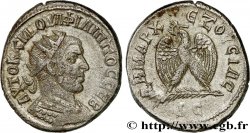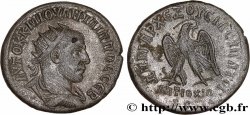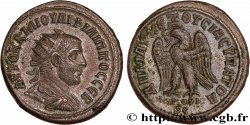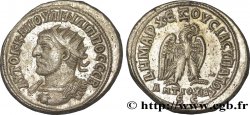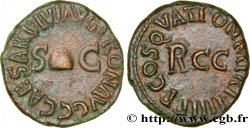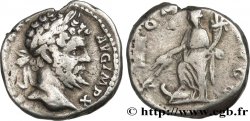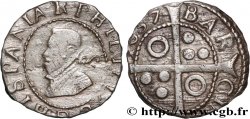bpv_309505 - PHILIPPUS I. ARABS Tétradrachme syro-phénicien
Nicht verfügbar.
Artikel auf unserem Online-Shop verkauft (2014)
Preis : 180.00 €
Artikel auf unserem Online-Shop verkauft (2014)
Preis : 180.00 €
Type : Tétradrachme syro-phénicien
Datum: 248
Name der Münzstätte / Stadt : Antioche, Syrie, Séleucie et Piérie
Metall : Scheidemünze
Durchmesser : 27,00 mm
Stempelstellung : 6 h.
Gewicht : 12,60 g.
Kommentare zum Erhaltungszustand:
Coins très frais, excellente frappe, beaux restes de brilant de frappe, infime usure de circulation sur le ventre de l’aigle
N° im Nachschlagewerk :
Pedigree :
Cet exemplaire est le 0354_039 de la base TSP
Vorderseite
Beschreibung Vorderseite Buste cuirassé à gauche, radié, les épaulettes décorées, avec aegis, vu de trois quarts en avant.
Legende des Averses AUTOK K M IOUL FILIPPOS SEB, (Autokratoros Kaisaros Markos Ioulios Filippos Sebastos)
Übersetzung der Vorderseite (L’empereur césar Marc Jules Philippe auguste).
Rückseite
Titulatur der Rückseite ANTIOXIA / S|C À L’EXERGUE.
Beschreibung Rückseite Aigle debout à droite, les ailes ouvertes, l’une passant derrière la patte gauche, tête à droite et queue à gauche, tenant une couronne feuillée dans son bec.
Legende des Reverses : DHMARC - EX OUSIAS UPATOG
Übersetzung der Rückseite (Revêtu de la puissance tribunitienne / Consul pour la troisième fois / avec l’accord du Sénat d’Antioche).
Kommentare
Les bustes cuirassés de Philippe présentent des variantes de décorations (avec et sans aegis, avec ou sans décorations sur les épaulettes) et d’attributs (trabea, bouclier... ) et se trouvent aussi bien radiés que laurés, à droite qu’à gauche.
En abordant les frappes du 3e consulat, on remarque l’absence complète de frappes datées du deuxième consulat, bien que le deuxième consulat de Philippe existe indubitablement à Rome, y compris sur les émissions monétaires. Interruption des frappes ou comput différent à Antioche qu’à Rome ? Nous penchons pour la deuxième solution, pour deux raisons.
Tout d’abord la continuité stylistique : tant pour les revers que pour les droits, il n’y a pas de rupture, alors que l’on aurait pu présumer une certaine normalisation après une interruption des frappes. De plus, celle-ci se produira effectivement pour les frappes datées du quatrième consulat avec un style d’aigle unique, suivie à la fin par une nouveauté encore plus marquante, l’introduction d’officines indiquées sur les monnaies.
Ensuite, il existe à Antioche de très nombreuses frappes datées d’un quatrième consulat de Philippe l’Arabe dont nous ne trouvons pas trace à Rome. Il est extrêmement regrettable que les quelques informations dont nous disposons sur le Sénat d’Antioche soient largement plus tardives (4e et 5e siècle) car les émissions de tétradrachmes laissent à penser que non seulement le Sénat d’Antioche manifestait son indépendance envers Rome en frappant de l’argent avec la titulature “SC / ANTIOXIA” mais encore qu’il avait son propre comput impérial sous Philippe.
L’apparition de cette exergue et la disparition de la palme sont caractéristiques des 3e et 4e consulat mais les styles des aigles ne se normaliseront qu’au 4e.
On note que les sigma sont gravés en C.
Dans la base TSP maintenue par Michel Prieur, cinquante-quatre exemplaires sont maintenant répertoriés pour ce type dont en musées British Museum, Jérusalem (2 ex Capharnaum), ANS (3) et Yale.
The armored busts of Philip present variations of decorations (with and without aegis, with or without decorations on the shoulder pads) and attributes (trabea, shield. . . ) and are found both radiated and laureates, on the right and on the left.
When approaching the strikes of the 3rd consulate, we notice the complete absence of strikes dated from the second consulate, although Philip's second consulate undoubtedly existed in Rome, including on monetary issues.. Was the minting interrupted or was the calculation different in Antioch than in Rome? We are inclined to choose the second solution, for two reasons..
First of all, stylistic continuity: for both the backhands and the forehands, there is no break, whereas one might have assumed a certain standardization after an interruption in the strokes. Furthermore, this will actually occur for the strikes dated from the fourth consulate with a unique eagle style, followed at the end by an even more striking novelty, the introduction of offices indicated on the coins..
Then, in Antioch there are many strikes dated to a fourth consulate of Philip the Arab, of which we find no trace in Rome.. It is extremely regrettable that the little information we have on the Senate of Antioch is much later (4th and 5th century) because the issues of tetradrachms suggest that not only did the Senate of Antioch demonstrate its independence from Rome by minting money with the title “SC / ANTIOXIA” but also that it had its own imperial computus under Philip.
The appearance of this exergue and the disappearance of the palm are characteristic of the 3rd and 4th consulate but the styles of the eagles will not become standardized until the 4th.
Note that the sigmas are engraved in C.
In the TSP database maintained by Michel Prieur, fifty-four examples are now listed for this type, including in museums such as the British Museum, Jerusalem (2 ex Capharnaum), ANS (3) and Yale
En abordant les frappes du 3e consulat, on remarque l’absence complète de frappes datées du deuxième consulat, bien que le deuxième consulat de Philippe existe indubitablement à Rome, y compris sur les émissions monétaires. Interruption des frappes ou comput différent à Antioche qu’à Rome ? Nous penchons pour la deuxième solution, pour deux raisons.
Tout d’abord la continuité stylistique : tant pour les revers que pour les droits, il n’y a pas de rupture, alors que l’on aurait pu présumer une certaine normalisation après une interruption des frappes. De plus, celle-ci se produira effectivement pour les frappes datées du quatrième consulat avec un style d’aigle unique, suivie à la fin par une nouveauté encore plus marquante, l’introduction d’officines indiquées sur les monnaies.
Ensuite, il existe à Antioche de très nombreuses frappes datées d’un quatrième consulat de Philippe l’Arabe dont nous ne trouvons pas trace à Rome. Il est extrêmement regrettable que les quelques informations dont nous disposons sur le Sénat d’Antioche soient largement plus tardives (4e et 5e siècle) car les émissions de tétradrachmes laissent à penser que non seulement le Sénat d’Antioche manifestait son indépendance envers Rome en frappant de l’argent avec la titulature “SC / ANTIOXIA” mais encore qu’il avait son propre comput impérial sous Philippe.
L’apparition de cette exergue et la disparition de la palme sont caractéristiques des 3e et 4e consulat mais les styles des aigles ne se normaliseront qu’au 4e.
On note que les sigma sont gravés en C.
Dans la base TSP maintenue par Michel Prieur, cinquante-quatre exemplaires sont maintenant répertoriés pour ce type dont en musées British Museum, Jérusalem (2 ex Capharnaum), ANS (3) et Yale.
The armored busts of Philip present variations of decorations (with and without aegis, with or without decorations on the shoulder pads) and attributes (trabea, shield. . . ) and are found both radiated and laureates, on the right and on the left.
When approaching the strikes of the 3rd consulate, we notice the complete absence of strikes dated from the second consulate, although Philip's second consulate undoubtedly existed in Rome, including on monetary issues.. Was the minting interrupted or was the calculation different in Antioch than in Rome? We are inclined to choose the second solution, for two reasons..
First of all, stylistic continuity: for both the backhands and the forehands, there is no break, whereas one might have assumed a certain standardization after an interruption in the strokes. Furthermore, this will actually occur for the strikes dated from the fourth consulate with a unique eagle style, followed at the end by an even more striking novelty, the introduction of offices indicated on the coins..
Then, in Antioch there are many strikes dated to a fourth consulate of Philip the Arab, of which we find no trace in Rome.. It is extremely regrettable that the little information we have on the Senate of Antioch is much later (4th and 5th century) because the issues of tetradrachms suggest that not only did the Senate of Antioch demonstrate its independence from Rome by minting money with the title “SC / ANTIOXIA” but also that it had its own imperial computus under Philip.
The appearance of this exergue and the disappearance of the palm are characteristic of the 3rd and 4th consulate but the styles of the eagles will not become standardized until the 4th.
Note that the sigmas are engraved in C.
In the TSP database maintained by Michel Prieur, fifty-four examples are now listed for this type, including in museums such as the British Museum, Jerusalem (2 ex Capharnaum), ANS (3) and Yale








 Berichten über einen Fehler
Berichten über einen Fehler Die Seite drucken
Die Seite drucken Teilen meiner Auswahl
Teilen meiner Auswahl Stellen Sie eine Frage
Stellen Sie eine Frage Einlieferung/Verkauf
Einlieferung/Verkauf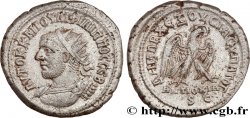
 Details
Details